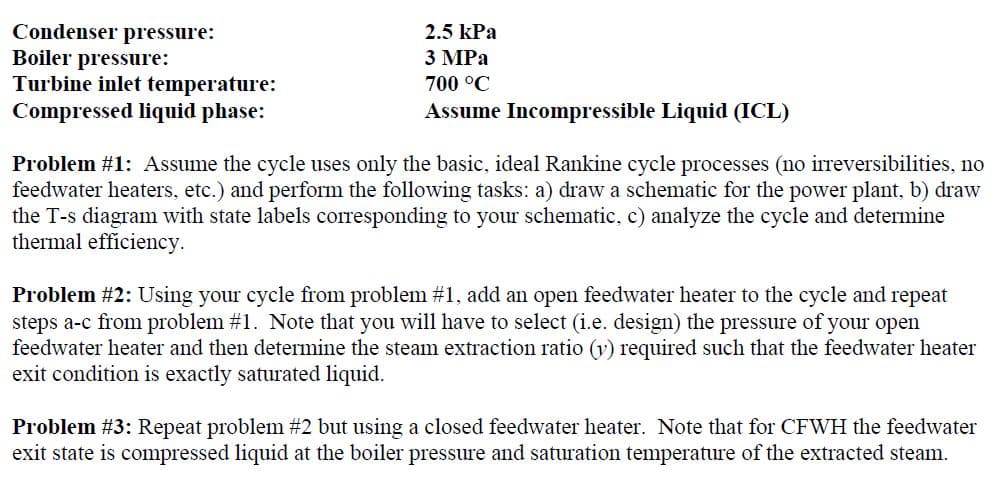Condenser pressure: Boiler pressure: Turbine inlet temperature: Compressed liquid phase: 2.5 kPa 3 MPa 700 °C Assume Incompressible Liquid (ICL) Problem #1: Assume the cycle uses only the basic, ideal Rankine cycle processes (no irreversibilities, no feedwater heaters, etc.) and perform the following tasks: a) draw a schematic for the power plant, b) draw the T-s diagram with state labels corresponding to your schematic, c) analyze the cycle and determine thermal efficiency. Problem #2: Using your cycle from problem #1, add an open feedwater heater to the cycle and repeat steps a-c from problem #1. Note that you will have to select (i.e. design) the pressure of your open feedwater heater and then determine the steam extraction ratio (v) required such that the feedwater heater exit condition is exactly saturated liquid. Problem #3: Repeat problem #2 but using a closed feedwater heater. Note that for CFWH the feedwater exit state is compressed liquid at the boiler pressure and saturation temperature of the extracted steam.
Condenser pressure: Boiler pressure: Turbine inlet temperature: Compressed liquid phase: 2.5 kPa 3 MPa 700 °C Assume Incompressible Liquid (ICL) Problem #1: Assume the cycle uses only the basic, ideal Rankine cycle processes (no irreversibilities, no feedwater heaters, etc.) and perform the following tasks: a) draw a schematic for the power plant, b) draw the T-s diagram with state labels corresponding to your schematic, c) analyze the cycle and determine thermal efficiency. Problem #2: Using your cycle from problem #1, add an open feedwater heater to the cycle and repeat steps a-c from problem #1. Note that you will have to select (i.e. design) the pressure of your open feedwater heater and then determine the steam extraction ratio (v) required such that the feedwater heater exit condition is exactly saturated liquid. Problem #3: Repeat problem #2 but using a closed feedwater heater. Note that for CFWH the feedwater exit state is compressed liquid at the boiler pressure and saturation temperature of the extracted steam.
Refrigeration and Air Conditioning Technology (MindTap Course List)
8th Edition
ISBN:9781305578296
Author:John Tomczyk, Eugene Silberstein, Bill Whitman, Bill Johnson
Publisher:John Tomczyk, Eugene Silberstein, Bill Whitman, Bill Johnson
Chapter45: Domestic Refrigerators And Freezers
Section: Chapter Questions
Problem 9RQ: The defrost cycle in a domestic refrigerator may be terminated by two methods: ___and___.
Related questions
Question
This is an Ideal Rankine Cycle with "Open Feedwater Heater'. We are to analyze the system but the pressure entering the feedwater is not provided. The task is to select/choose an appropriate pressure value for the feedwater, which will then yield the best efficiency. I really need some help to get this done correctly. Thanks for your time.

Transcribed Image Text:Condenser pressure:
Boiler pressure:
Turbine inlet temperature:
Compressed liquid phase:
2.5 kPa
3 MPa
700 °C
Assume Incompressible Liquid (ICL)
Problem #1: Assume the cycle uses only the basic, ideal Rankine cycle processes (no irreversibilities, no
feedwater heaters, etc.) and perform the following tasks: a) draw a schematic for the power plant, b) draw
the T-s diagram with state labels corresponding to your schematic, c) analyze the cycle and determine
thermal efficiency.
Problem #2: Using your cycle from problem #1, add an open feedwater heater to the cycle and repeat
steps a-c from problem #1. Note that you will have to select (i.e. design) the pressure of your open
feedwater heater and then determine the steam extraction ratio (v) required such that the feedwater heater
exit condition is exactly saturated liquid.
Problem #3: Repeat problem #2 but using a closed feedwater heater. Note that for CFWH the feedwater
exit state is compressed liquid at the boiler pressure and saturation temperature of the extracted steam.
Expert Solution
This question has been solved!
Explore an expertly crafted, step-by-step solution for a thorough understanding of key concepts.
This is a popular solution!
Trending now
This is a popular solution!
Step by step
Solved in 4 steps with 8 images

Knowledge Booster
Learn more about
Need a deep-dive on the concept behind this application? Look no further. Learn more about this topic, mechanical-engineering and related others by exploring similar questions and additional content below.Recommended textbooks for you

Refrigeration and Air Conditioning Technology (Mi…
Mechanical Engineering
ISBN:
9781305578296
Author:
John Tomczyk, Eugene Silberstein, Bill Whitman, Bill Johnson
Publisher:
Cengage Learning

Refrigeration and Air Conditioning Technology (Mi…
Mechanical Engineering
ISBN:
9781305578296
Author:
John Tomczyk, Eugene Silberstein, Bill Whitman, Bill Johnson
Publisher:
Cengage Learning